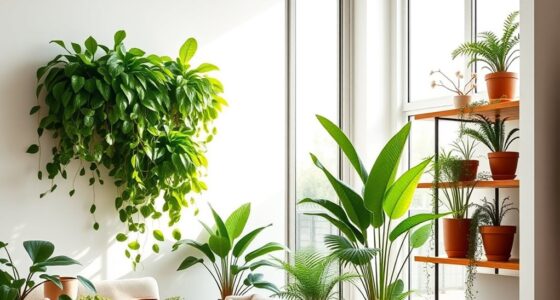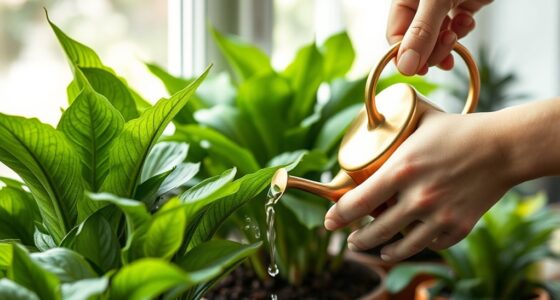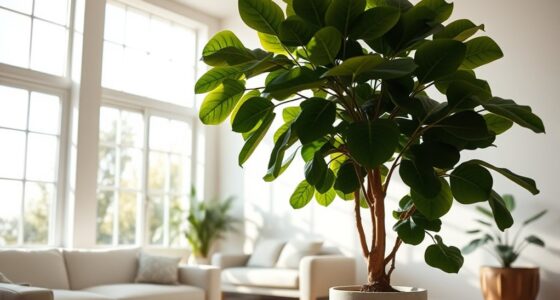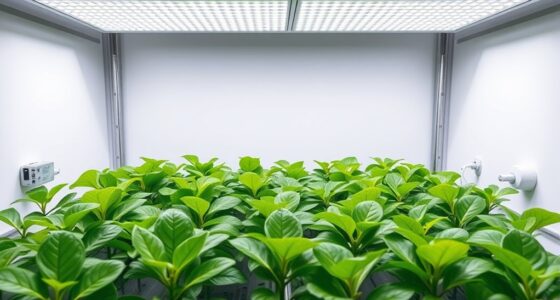You can reduce indoor allergens by choosing air-purifying plants like snake plants, pothos, and peace lilies that are easy to care for and less likely to trap dust or produce pollen. Regularly wiping their leaves, avoiding overwatering, and ensuring good air circulation help prevent mold and dust buildup. Position plants away from high-traffic areas and keep the environment tidy. To discover more tips on creating a healthier indoor space, keep exploring ways to maintain your plants effectively.
Key Takeaways
- Select air-purifying, low-allergen plants like snake plants, pothos, and peace lilies for indoor spaces.
- Regularly wipe plant leaves and clean containers to remove dust, pollen, and mold spores.
- Avoid lush or fuzzy plants that trap dust or produce excessive pollen, reducing allergen accumulation.
- Maintain proper watering, good airflow, and dry soil conditions to prevent mold growth on plants.
- Position plants away from high-traffic areas and dust sources to minimize allergen exposure.
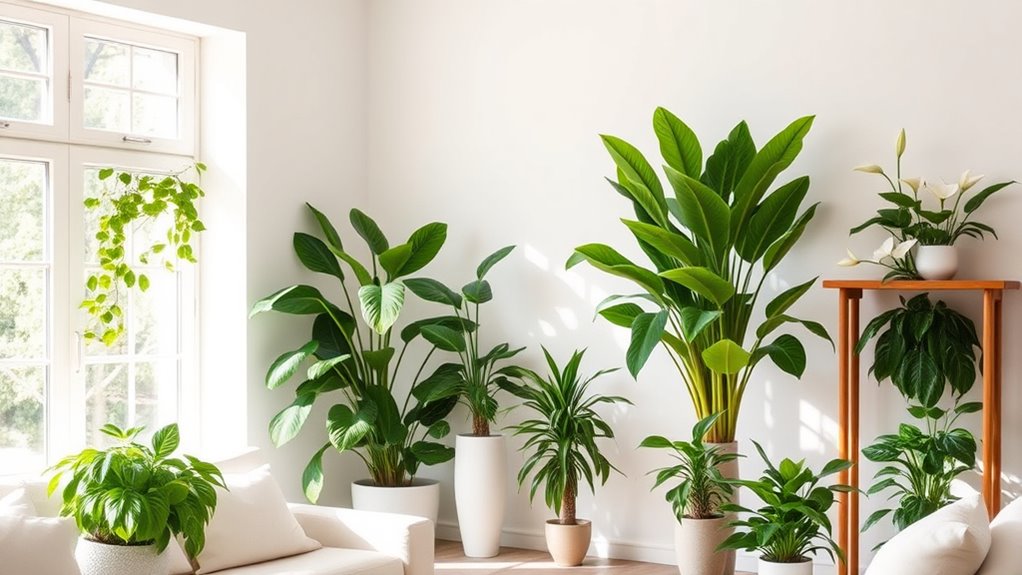
Indoor allergens like dust, mold, and pet dander can make allergy symptoms worse, but incorporating certain plants into your home can help reduce these irritants. Choosing the right plants is essential, so your plant selection should focus on varieties known for their air-purifying qualities and low allergenic potential. Look for plants like snake plants, pothos, and peace lilies, which are known to filter airborne toxins and improve indoor air quality. When selecting plants, opt for those that are easy to care for and less likely to accumulate mold or dust, as these factors can contribute to allergy symptoms. Avoid overly lush or fuzzy plants that trap dust or produce excessive pollen, which might worsen your allergies.
Once you’ve picked the right plants, maintaining them properly becomes fundamental for maximizing their benefits and preventing them from becoming allergen sources themselves. Regular maintenance tips include wiping down the leaves with a damp cloth to remove dust and pollen, which can settle and cause irritation if left uncleaned. Proper watering is also critical; overwatering can promote mold growth in the soil, so ensure your plants are not sitting in water and that the soil drains well. Using well-draining pots with saucers can help prevent excess moisture. Additionally, placing your plants in areas with good air circulation and avoiding overly humid spots can inhibit mold growth on both the plants and surrounding surfaces. Sound design techniques can be employed to create an audio environment that promotes a sense of calm and cleanliness, reinforcing the benefits of a tidy space.
Another key maintenance tip is to keep the soil surface dry and replace it periodically if it appears moldy or compacted. Cleaning plant containers regularly reduces the chance of mold spores spreading through your indoor environment. When handling your plants, wash your hands afterward and avoid touching your face, especially if you have allergies or asthma. Keep the area around your plants clean by vacuuming or dusting nearby surfaces to prevent dust buildup, which can contribute to allergy flare-ups. Also, consider positioning your plants away from high-traffic areas where dust and pet dander are most likely to settle on their leaves.
Frequently Asked Questions
Which Plants Are Most Effective for Allergen Reduction Indoors?
You should choose air purifying plants like snake plants, pothos, and peace lilies for allergen reduction indoors. These plants have allergen reducing foliage that can filter airborne irritants and improve air quality. By placing a few of these in your living space, you actively diminish indoor allergens, creating a healthier environment. Regular care ensures they thrive and continue to help minimize allergens effectively.
How Often Should Indoor Plants Be Cleaned to Maintain Air Quality?
Imagine your indoor garden as a tiny city that needs regular upkeep. You should clean your plants once a week to keep them thriving. During this routine, gently wipe leaves to remove dust and pests, which act like tiny invaders. When watering, check for pests and remove any dead or yellowing leaves. This routine helps maintain healthy plants, improves air quality, and keeps pests at bay, ensuring your plant city stays vibrant.
Can Certain Plants Worsen Indoor Allergies?
Yes, certain plants can worsen indoor allergies. Some plants have high pollen production, which can trigger allergic reactions, especially in sensitive individuals. Additionally, plant toxicity is a concern if you have pets or children, as ingesting toxic plants can cause health issues. Be sure to choose low-pollen, non-toxic plants like pothos or snake plants to improve air quality without risking allergy symptoms or toxicity.
Are There Specific Placements for Plants to Maximize Allergen Reduction?
Think of your plants as indoor air superheroes, fighting allergens from their strategic posts. To maximize allergen reduction, place them near trouble spots like entryways, living rooms, or bedrooms, where they can intercept airborne particles before they settle. Keep plants at ideal positioning—away from vents and direct sunlight—to guarantee they thrive and work efficiently. Proper plant placement turns your space into a clean-air sanctuary, breathing easier every day.
Do Indoor Plants Impact Other Indoor Air Pollutants Besides Allergens?
Indoor plants do impact other air pollutants besides allergens, especially when combined with air purifier synergy. They help filter out volatile organic compounds (VOCs) and improve air quality through natural mechanisms. Additionally, plants aid in humidity regulation, preventing mold growth and reducing dust mites. Together, these effects create a healthier indoor environment. Keep in mind, proper placement enhances these benefits, so strategically position plants for maximum pollutant reduction.
Conclusion
By bringing plants into your home, you create a lush shield that whispers away indoor allergens like a gentle breeze clearing storm clouds. These green guardians breathe life into your space, transforming it into a invigorating oasis where allergens retreat and comfort blossoms. With each leaf, you’re crafting a sanctuary—vibrant, calming, and full of nature’s quiet power. So, nurture your indoor jungle and let it work its magic, turning your home into a breath of fresh atmosphere.


